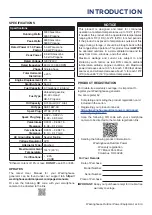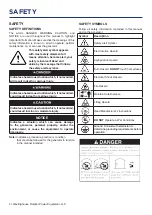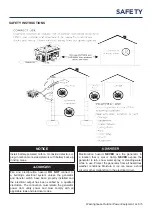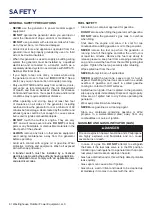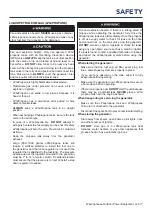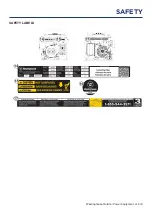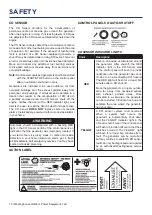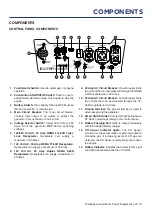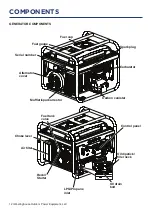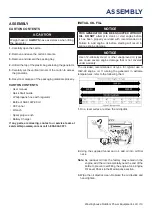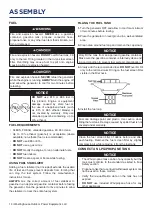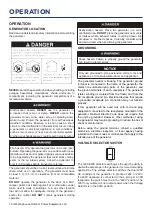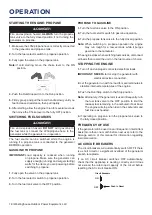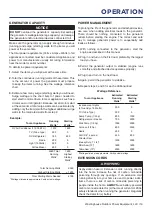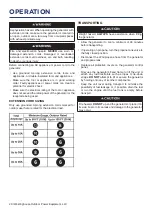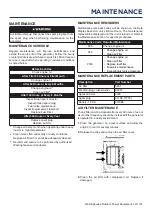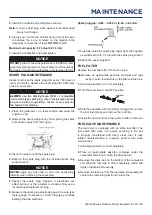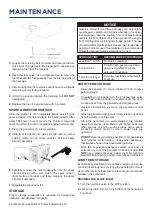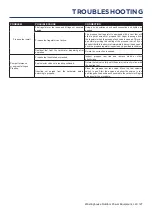
16 | Westinghouse Outdoor Power Equipment, LLC
OPERATION
GENERATOR LOCATION
Read and understand all safety information before starting
the generator.
NEVER
operate the generator inside any building, including
garages, basements, crawlspaces, sheds, enclosure, or
compartment, including the generator compartment of a
recreational vehicle.
Electrocution hazard.
NEVER
use the generator in
a location that is wet or damp.
NEVER
expose the
generator to rain, snow, water spray, or standing water
while in use. Protect the generator from all hazardous
weather conditions. Moisture or ice can cause a short
circuit or other malfunction in the electrical circuit. Using
a generator or electrical appliance in wet conditions,
such as rain or snow, or near a pool or sprinkler system,
or when your hands are wet, could result in electrocution
Fire hazard. Only operate the generator on a solid, level
surface. Operating the generator on a surface with loose
material such as sand or grass clippings can cause debris
to be ingested by the generator that could block cooling
vents or the air intake system. Allow the generator to
cool for 30 minutes before transport or storage.
The generator should be on a flat, level surface at all times
(Even while not in operation). The generator must have
at least 5 ft. (1.5 m) of clearance from all combustible
material.
DO NOT
operate the generator in the back of a SUV,
camper, trailer, truck bed (regular, flat, or otherwise), under
stairs, next to walls or buildings, or in any other location
that will not allow for adequate cooling of the generator
and/or the muffler.
DO NOT
contain generators during
operation.
Asphyxiation hazard. Place the generator in a well-
ventilated area.
DO NOT
place the generator near vents
or intakes where exhaust fumes could be drawn into
occupied or confined spaces. Carefully consider wind
and air currents when positioning the generator.
GROUNDING
Shock hazard. Failure to properly ground the generator
can result in electric shock.
NOTICE
Only use grounded 3-prong extension cords, tools, and
appliances, or double-insulated tools and appliances.
The generator neutral is floating. The generator ground
t
erminal is connected to the frame of the generator, the
metal non-current-carrying parts of the generator, and
the ground terminals of each receptacle. The generator
(stator winding) is isolated from the frame and from the
AC receptacle ground pin. Electrical devices that require
a grounded receptacle pin connection may not function
properly.
If this generator will be used only with cord and plug
equipment connected to the receptacles mounted on the
generator, National Electric Code does not require that
the unit be grounded. However, other methods of using
the generator may require grounding to reduce the risk of
shock or electrocution.
Before using the ground terminal, consult a qualified
electrician, electrical inspector, or local agency having
jurisdiction for local codes or ordinances that apply to the
intended use of the generator.
VOLTAGE SELECTOR SWITCH
The 120V/240V selector switch gives the user the ability to
double the amperage in the generator for more demanding
applications. The voltage selector switches the dual 120V
AC windings of the generator to produce 120V or 240V.
If a 240V appliance is connected to the 4-prong L14-30R
receptacle, the switch must be in the “240V” position. The
120V only outlets will not output power when the Voltage
Selector is in the 240V position.
OPERATION
Summary of Contents for WGEN5300DFC
Page 8: ...8 Westinghouse Outdoor Power Equipment LLC SAFETY LABELS SAFETY...
Page 9: ...Westinghouse Outdoor Power Equipment LLC 9 SAFETY SAFETY LABELS...
Page 31: ...Westinghouse Outdoor Power Equipment LLC 31 EXPLODED VIEWS GENERATOR EXPLODED VIEW...
Page 34: ...34 Westinghouse Outdoor Power Equipment LLC SCHEMATICS SCHEMATICS SCHEMATICS...


